Through You
February/March 2012
Through You was an interactive active artwork that happened in 2011/12, developed from work started at the Soundfjord Gallery, where we experimented playing sounds into objects
(See previous post https://shirleypegna.com/process-in-focus/).
As you can imagine from the title it involved playing sounds through your self. It was one in a series of works made, along with Through Walls and Through The Bathwater.
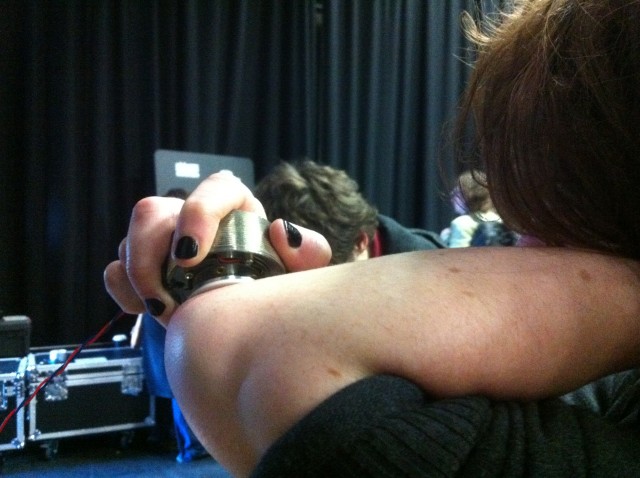
Beam workshopday participant
I developed a battery kit with sound artist Matt Davies (http://www.audiblefields.com/ ) , where you could walk around and play sounds into any object and yourself. An mp3 player connected to a small amp and battery played sound into a transducer that vibrated sound into objects, and peoples’ bodies. I tried these kits at several places progressively adding different sounds: at Audiograft 2012 – Oxford, Bath Spa University, Oxford Brookes University, BEAM Workshop Day – Brunel University and Fir Tree Junior School – Wallingford.

Bag,transduce and mp3player
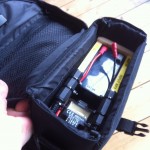
Inside the kit bag- a battery and amp
There were several events of Through You, where I introduced more and different sounds for people to play through the transducers. I tried different sounds:
• speech – speeds of sound
• sung vocal sound
• low frequency sounds -both audible and inaudible
• high frequency sounds – both audible and inaudible
• recognisable body sounds like heart beat
• breathing
• less recognisable sounds which were also internal body sounds
I was interested to see what the reaction was of these different sounds. How people heard sounds differently, in this case through them selves, and especially to the reaction of extreme sounds: did they have associations with these odd internal sounds coming to their ears? In the case of the speech, did they for instance listen to the words? Most importantly -What did they think of sounds on the edge of their usual perception?
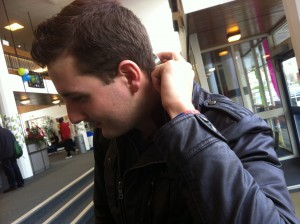
Participant at Audiograft 2012
I was interested to see what the reaction was of these different sounds. How people heard sounds differently, in this case through them selves, and especially to the reaction of extreme sounds: did they have associations with these odd internal sounds coming to their ears? In the case of the speech, did they for instance listen to the words? Most importantly -What did they think of sounds on the edge of their usual perception?
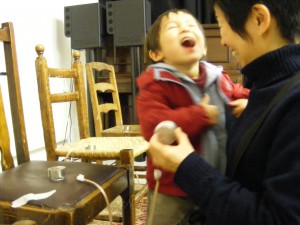
Visitors to the Soundfjord Gallery -London
It prompted them to think about how we think about our hearing and ask – “what do our ears make us aware of?” I’m inviting participants to become aware of, and question: “which sounds do I heard from within and which sounds from outside?”
The activity of playing sound into the body is unusual, but we are some times aware of sounds from inside our heads. More usual is the internal sound in our ears from either our blood racing when our heart pumps fast or ringing sounds of some sort from tinnitus.

Stidents from Oxford Brookes University – Audiograft 2012
I wanted to form and ask the participants specific questions, but each situation brought the same amazement at the physical behaviour of our body (as a material) and the way it conducted sound and our experience of sound ‘s behaviour in our body – the way we heard it. So experience and exploration needed to come first and then the questions asked needed to arise from individual experiences.
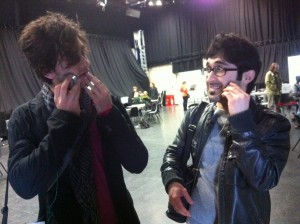
Visitors to the Beam Day Workshop
I wondered how safe an activity this was and asked a Physicist from Bristol University, an Audiologist also from Bristol University, a GP, and an Electro Engineer. Importantly, the main outcome from my enquiries was that in terms of health and safety the activity was safe, but the journey in questioning the different experts introduced me to the span of expertise concerned with our ears and their behaviour.

Knee being tested at Beam Day Workshop
To sum up, this proved to be a rich vein of enquiry, and there was a lot of varied feedback. People were hearing outside sounds from inside themselves, which gave this disembodied sound a disconnectedness that required the listener to think twice about – where they were hearing from.
Steven Connor comments, from his talk Auscultations: Listening I, that the ear is ‘half anatomy and half imagination’. We don’t often focus on where we imagine sounds are heard. Is it heard in the ear – or in the brain registering the ears sounds? ‘If we can say space is described by sound and sound is the space in which it occurs, it causes a disruption in our habit of listening, and listening to inside generated sounds brings a focus to what it means to hear sounds.’
http://www.sonicacts.com/portal/index.php/steven-connor-auscultations-listening-in/
Laurie Anderson’s Table Piece was a beautifully presented gallery example of focusing on sound through the bones of the elbow and arm to the ear.
http://testpressing.org/2011/03/exhibition-laurie-anderson-trisha-brown-gordon-matta-clark-pioneers-of-the-downtown-scene-new-york-1970s/
Bernard Leitner in his piece Sound Chair started a series of work where he developed the idea of sound and music travelling through the body.
http://www.bernhardleitner.com/works
Kaffe Mathews – Music for Bodies -Sonic Bed, explored sound, especially vibration travelling through the body.
http://www.musicforbodies.net/wiki/InstrumentLab
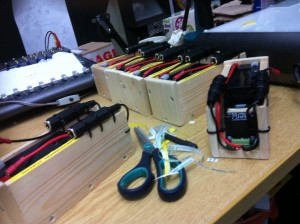
Multiple sound kits in the making
Feedback
• ‘Good fun!’
• ‘It’s really cool!’
• ‘Putting the transducer on my temple/side of my skull I had the experience of hearing sounds also on the other side of my head as if from an external sound source/loudspeaker but with nothing there – phantom sound!’
• ‘Great experience. There will be no use of speakers soon!’
• ‘When you put it into your body you start to feel more mechanical about it – is it ‘spatial out’ or ‘spatial in?’
• ‘Well done I really like it – amazing –‘
• ‘I wanted to go on a journey with them and explore making every thing into a speaker. I like that sense if being personal, but they did have a kind of medical quality: the bags and the stainless steel.’

Sound played into the hand
• ‘I almost wanted them to be huge to stand on them – the transducers.’
• ‘ I put them on my spine and it almost hurt and I put them on my ear and elbow and it was nice.’
• ‘I felt it intrusive – very powerful especially not knowing what the sound was.’
• ‘I found it really amazing.’
• ‘It’s an interesting reversal to have instead of the machine recording- it’s ‘out putting’.
• ‘Strange relaxing weird but nice….’
• ‘This is really amazing! Love the low one (sound), it’s very relaxing, clever and I’ve never seen anything like it. Listen with your body.’
• ‘Really nice great invention, heard by your bones it my first time to see it well done
great great great.’
• ‘Awesome idea! Really like the thought of hearing through the body – would be interesting to have a floor of these, all playing different things: as someone walks across the sound and music they hear changes.Delicious!’
• ‘Amazing! A new way of hearing! Feeling some sounds very weird, especially hearing heartbeat inside your head! Great to experience something different.’
• ‘I really loved the heart and lungs – I found it fascinating and hard to put it down!’
• ‘When I tried it – I had a feeling that I doubted my own sense: I felt spooked cos it sounded, when I put it on my head, very loud and I had to ask Aya if she could hear that. ‘
• ‘It’s taking on bits of extraterrestrial technology. It’s enlightening to encounter such things.’
• ‘Mixes sound and touch – like a little hamster vibrating in your hand.’
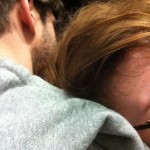
End